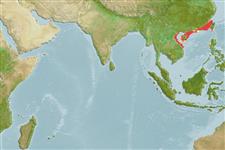Elasmobranchii (haaien en roggen) (sharks and rays) >
Torpediniformes (Electric rays) >
Platyrhinidae (Fanrays)
Etymology: Platyrhina: Greek, platys = flat + Greek, rhinos = nose. It is the same voice used for the Mammalian division made in Primates (Ref. 45335).
More on authors: Bloch & Schneider.
Environment: milieu / climate zone / depth range / distribution range
Ecologie
marien demersaal; oceanodroom (Ref. 51243). Subtropical; 25°N - 15°N, 105°E - 120°E (Ref. 114953)
Northwest Pacific: Chinese coast of Taiwan Strait and in the South China Sea to northern Vietnamese waters; not confirmed from Japanese, South Korean or Taiwanese waters (likely to occur in Taiwan).
Grootte / Gewicht / Leeftijd
Maturity: Lm ? range ? - ? cm
Max length : 86.3 cm TL mannelijk / geslacht onbekend; (Ref. 83530); common length : 50.0 cm TL mannelijk / geslacht onbekend; (Ref. 637)
This species is distinguished from its congeners in having the following set of characters: two rows of thorns (strongly hooked and gradually becoming somewhat embedded toward first dorsal fin origin) on mid-dorsum of tail; no thorns at the anterior part of scapular region; thorns on the orbital, nape and scapular regions not encircled by light yellow or white pigment; dorsal surface covered with minute dermal denticles of uniform size and shape, no obvious larger dermal denticles (smooth to touch) (Ref. 86259).
Found inshore (Ref. 9903), above 60 m on rock or rocky sand bottoms (Ref. 11230). Ovoviviparous (Ref. 50449). Biology little known (Ref. 9903).
Levenscyclus en paargedrag
Maturiteit | Voortplanting | Paaien | Eieren | Fecunditeit | Larven
Exhibit ovoviparity (aplacental viviparity), with embryos feeding initially on yolk, then receiving additional nourishment from the mother by indirect absorption of uterine fluid enriched with mucus, fat or protein through specialised structures (Ref. 50449).
Compagno, L.J.V. and P.R. Last, 1999. Platyrhinidae. Thornback rays. p. 1431-1432. In K.E. Carpenter and V.H. Niem (eds.) FAO identification guide for fishery purposes. The living marine resources of the Western Central Pacific. Rome, FAO. (Ref. 9903)
Status op de Rode Lijst van het IUCN (Ref. 130435: Version 2024-1)
Gebruik door de mens
Visserij:
Tools
Speciale rapporten
Download XML
Internetbronnen
Estimates based on models
Preferred temperature (Ref.
123201): 22.8 - 26.7, mean 25.2 °C (based on 112 cells).
Fylogenetische diversiteitsindex (Ref.
82804): PD
50 = 0.6250 [Uniqueness, from 0.5 = low to 2.0 = high].
Bayesian length-weight: a=0.01000 (0.00244 - 0.04107), b=3.04 (2.81 - 3.27), in cm total length, based on all LWR estimates for this body shape (Ref.
93245).
Trofisch niveau (Ref.
69278): 3.5 ±0.37 se; based on food items.
Weerstandsvermogen (Ref.
120179): laag, minimale populatieverdubbelingstijd 4,5-14 jaar (Fec assumed to be <100).
Fishing Vulnerability (Ref.
59153): Moderate to high vulnerability (55 of 100).
